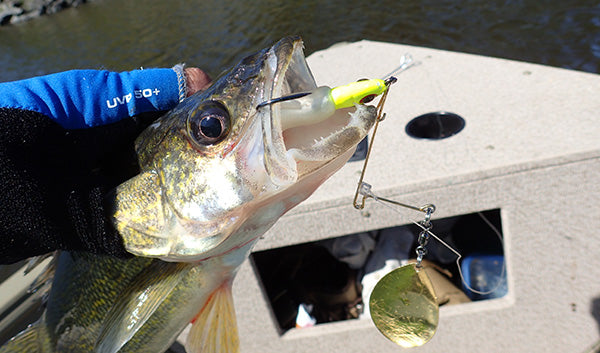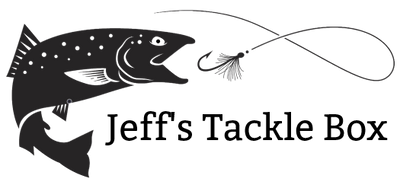
It’s time for another look at this style of bait and the rigging that works best. I just got back from another of the McGovern family trips to Canada fishing Lake of the  Woods. As with the last three years, the Redfish Magic type lures caught the vast majority of the fish for everyone. Even folks not in our group, who we had told about the lures years back, were using them with equal success. It did
Woods. As with the last three years, the Redfish Magic type lures caught the vast majority of the fish for everyone. Even folks not in our group, who we had told about the lures years back, were using them with equal success. It did  not even matter what species of fish — northern pike, muskie, walleye, and smallmouth bass all succumbed to these baits. If you have not tried this type of lure (especially if you live in the northern areas), don’t do it unless you are prepared to catch fish after fish.
not even matter what species of fish — northern pike, muskie, walleye, and smallmouth bass all succumbed to these baits. If you have not tried this type of lure (especially if you live in the northern areas), don’t do it unless you are prepared to catch fish after fish.
I’ve gotten to the point where I build them as required from available rigging. But if you chose to tear open a Redfish Magic and use it straight from the package, that’s fine too. They are considered saltwater bait. The original design is called a jig spinner. The first of its type was the Beetle Spin, which you can read about in another article here on this site. Redfish Magic was intended to be a heavy weight version to catch redfish in US coastal inshore waters. It works very well as intended, but when you transition to freshwater, it works even better. The lure is two sections: a jig spinner harness with a blade swivel combo, a safety pin type clasp, and then a jig head which attaches to the clasp. The jig head can be adorned with a variety of trailers from plastic to bucktail. You can vary the weight of the presentation by simply going to a lighter or heavier jig head.
Rigging properly gets the most out of this style lure. I avoid the use of as much hardware as possible for this bait. My preferred method of use is to tie a leader to my main line first. Last week in Canada, it was 15 lb fluorocarbon for 8lb mono line and 20lb fluorocarbon for heavier lines. The leader is attached to the main line using a four turn surgeon’s knot. The lure is tied to the leader using a  canoeman’s loop knot. Both those knots can be found and explained here in this site, as well. Most important, before tying on the lure, is to put a small section of 1/8 inch ID clear plastic tubing over the “R” bend of the shaft. This creates a closed attachment loop and prevents the leader loop from sliding onto the shaft of the harness. It also adds a movement or articulation point
canoeman’s loop knot. Both those knots can be found and explained here in this site, as well. Most important, before tying on the lure, is to put a small section of 1/8 inch ID clear plastic tubing over the “R” bend of the shaft. This creates a closed attachment loop and prevents the leader loop from sliding onto the shaft of the harness. It also adds a movement or articulation point  so the bait has more action in the water. With zero hardware (metal leaders, snaps, and swivels), you will catch more fish. The fluorocarbon leader is tough enough for even toothy fish like pike and muskie.
so the bait has more action in the water. With zero hardware (metal leaders, snaps, and swivels), you will catch more fish. The fluorocarbon leader is tough enough for even toothy fish like pike and muskie.
Our success with this type of lure and rigging is unbelievable. When we introduce it to other anglers, they are a bit skeptical. However, after they make the first attempt, they are solidly hooked. What’s funny is how this usually happens. We talk about the bait and even show pictures. They smile and say “Hey, that’s great!” and give the lure to their kids to try first. You know– too simple, only one hook, great for kids– all that sort of thing. Then, on the first day with it on the water, they are right back casting their expensive baits with loads of gang trebles on them. Of course, the kids are just catching fish right and left with Redfish Magics, while the adults pull in empty lures. By about 10AM, and who knows how much bribery, everyone is fishing them. When the group heads in for the day, the live well is full and there are some great shots in the camera.
For those of you reading this with a little skepticism, I understand. The lure is  cheaper than most and does not have flashy lights or a
cheaper than most and does not have flashy lights or a  super realistic finish. Put that aside and buy some–you won’t be disappointed. Follow the rigging instructions and make sure you have strong arms for all the pulling you will be doing. The best places to find them in the south are places that sell saltwater tackle. In the north, you can find them online in the saltwater lure sections of the Bass Pro Shops or Cabela’s website.
super realistic finish. Put that aside and buy some–you won’t be disappointed. Follow the rigging instructions and make sure you have strong arms for all the pulling you will be doing. The best places to find them in the south are places that sell saltwater tackle. In the north, you can find them online in the saltwater lure sections of the Bass Pro Shops or Cabela’s website.
